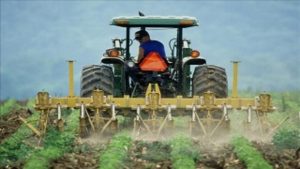JUNE 26, 2018

“Think about trying to live today on the income you had 15 years ago.” That’s how agriculture expert Chris Hurt describes the plight facing U.S. farmers today.
The unequal economy that’s emerged over the past decade, combined with patchy access to health care in rural areas, have had a severe impact on the people growing America’s food. Recent data shows just how much. Farmers are dying by suicide at a higher rate than any other occupational group, according to the Centers for Disease Control and Prevention.
The suicide rate in the field of farming, fishing and forestry is 84.5 per 100,000 people—more than five times that of the population as a whole. That’s even as the nation overall has seen an increase in suicide rates over the last 30 years.
The CDC study comes with a few caveats. It looked at workers over 17 different states, but it left out some major agricultural states, like Iowa. And the occupational category that includes these workers includes small numbers of workers from related occupational groups, like fishing and forestry. (However, agricultural workers make up the vast majority of the “farming, fishing and forestry” occupational group.)
However, the figures in the CDC study mirror other recent findings. Rates of suicide have risen fastest, and are highest, in rural areas, the CDC found in a different study released earlier this month. Other countries have seen this issue, too–including India, where 60,000 farmer suicides have been linked to climate change.
In the U.S., several longtime farm advocates say today’s crisis mirrors one that happened in the 1980s, when many U.S. farmers struggled economically, with an accompanying spike in farmer suicides.
“The farm crisis was so bad, there was a terrible outbreak of suicide and depression,” said Jennifer Fahy, communications director with Farm Aid, a group founded in 1985 that advocates for farmers. Today, she said, “I think it’s actually worse.”
“We’re hearing from farmers on our hotline that farmer stress is extremely high,” Fahy said. “Every time there’s more uncertainty around issues around the farm economy is another day of phones ringing off the hook.”
Addressing the rise in suicide
Finances are a major reason. Since 2013, farm income has been dropping steadily, according to the U.S. Department of Agriculture. This year, the average farm’s income is projected to be 35 percent below its 2013 level
“The current incomes we’ve seen for the last three years … have been about like farm incomes from early in this century,” said Hurt, a professor of agricultural economics at Purdue University in Indiana.
Farmers are also at the mercy of elements outside their direct control, from extreme weather events that threaten crops to commodity prices that offer less for farm goods than it costs to produce them.
“We’ve spoken to dairy farmers who are losing money on every pound of milk they sell,” said Alana Knudson, co-director of the Walsh Center for Rural Health Analysis with the University of Chicago.
As America’s trading partners slap tariffs on U.S. crops, those prices are set to be further undermined. Meanwhile, the Federal Reserve’s gradual raising of interest rates threatens the financing for many smaller farms.
“A lot of our farmers take out operating loans so they can buy seed, fertilizer and spray. As we’re looking at increasing interest rates, this is going to exacerbate financial vulnerability,” Knudson said.
Unreliable finances are a major reason why three-quarters of farmers must rely on non-farm income, often from a second job. Health insurance access is another.
Health care and mental-health services can be critical, Knudson said, particularly in rural areas, where medical care may be scarce. The farm bill that passed the House last week threatens to undo that, she said, because it allows for health insurance to sell plans that exclude mental health coverage. The Senate version of the farm bill allocates $20 million to a program to connect farmers with behavioral health services.
Such programs are even more crucial today, said Fahy, because many publicly-funded programs that were created in the wake of the 1980s farm crisis have been chipped away over the years. She pointed to Minnesota, where a suicide hotline closed earlier this month after a budget dispute between the legislature and the governor.
“Farmer stress right now is extremely high, the farm economy is very precarious and not predicted to improve in the near future,” she said. However, she added, “When there are steps in place to address the root cause, which is usually financial and legal, the stress becomes manageable.”
Because people can feel stigma around issues of mental health, conversation is important, said Doug Samuel, associate psychology professor at Purdue University.
“When you’re looking at someone who you have a concern about,” Samuel advised, “don’t be afraid to ask, don’t be afraid to listen.”
Courtesy/Source: CBS News









































































































